Purposeful Play Book Study- Section 2: The Work in Play
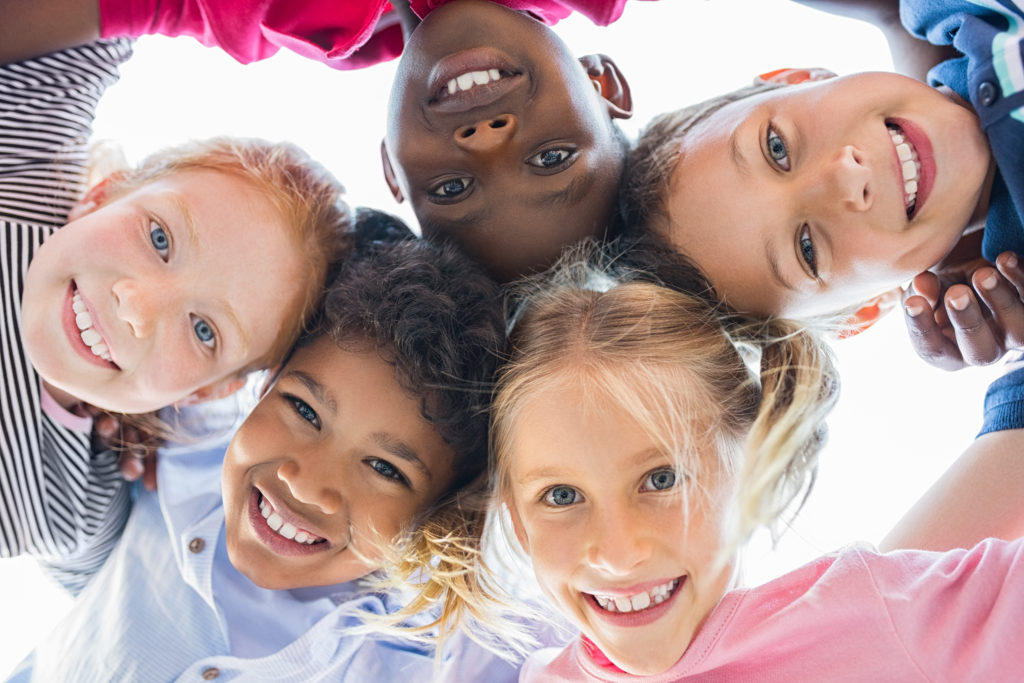
Hi there! Thanks so much for joining us for section 2 of the Purposeful Play Book study! If you missed section 1 you can view it HERE.
If you haven’t picked up the Purposeful Play text you can still follow along with us here but I strongly urge you to snag the book for yourself. It’s a page turner and as you read the author’s take on play you too will have a passion that grows (even more than you already had for play). You can view the Purposeful Play text on Amazon HERE.
The Work in Play –Using play for Social and Emotional Growth
We have established the various types of play. Now, we have our classrooms overhauled, primed and ready for this magical hour of children playing together. We just can’t wait to see the blossoming happen –the collaborative and imaginative play take place! Then, it happens. We experience the first 5 minutes of “play” and think to ourselves, “Oh no, what have I gotten myself into –this is NOT what I imagined!”
We have to address this seemingly “uh-oh” that unfolded. Many times we become discouraged in the moment by our pre-conceived perception of what something should or will look like. Especially with play, we cannot micro-manage every step of the way. Play is essentially their work. Any work takes practice and opportunity to experience growth. The children need consistent opportunity, along with your help (the tools you provide) in order to do the productive work in play. The “uh-oh” will soon become your “ah-ha” moment.
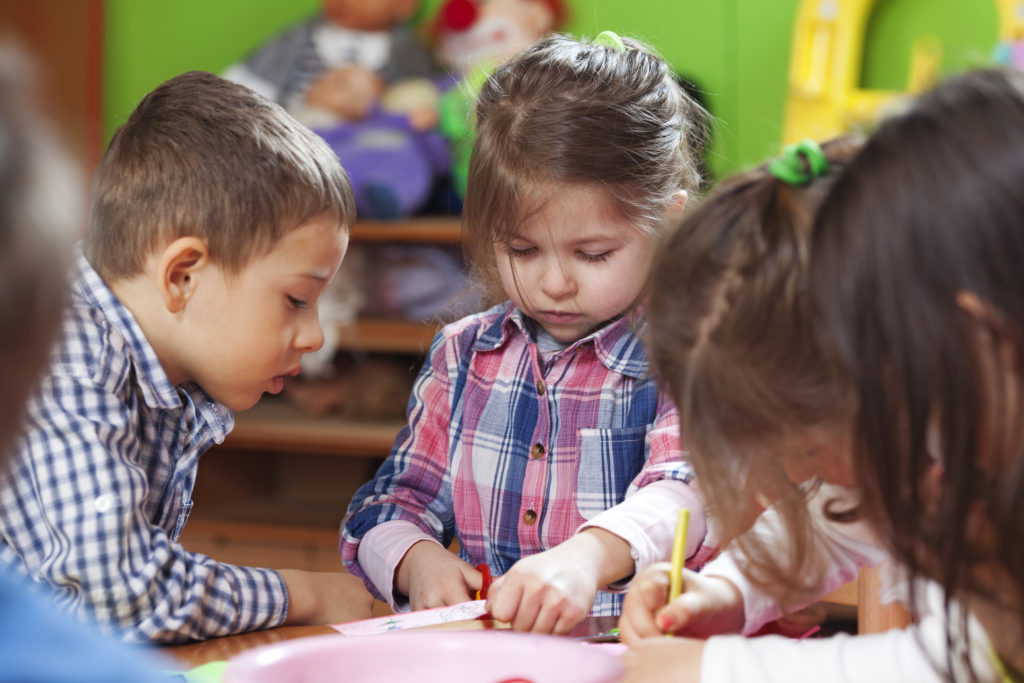
Caring Kids-Teaching Empathy through Play
What exactly is empathy? Empathy is defined as “our ability to feel what another person is feeling COMBINED with an ability to take on another’s perspective.” Essentially, empathy is a two-part emotional behavior. Empathy is nurtured through both emotional experiences and social experiences.
Emotional experiences from infancy are building blocks, empathy “needs certain conditions to blossom fully within us, and when nourished, it is a quality that is typically developed as we grow from infants to toddlers to young children”. Exposure to an array of emotions gives us the skillset to read others’ feelings. Exposure builds our emotional vocabulary. On the other hand, a child who lacks exposure and experiences little feelings of love or connection may be left immature in their ability to emotionally connect.
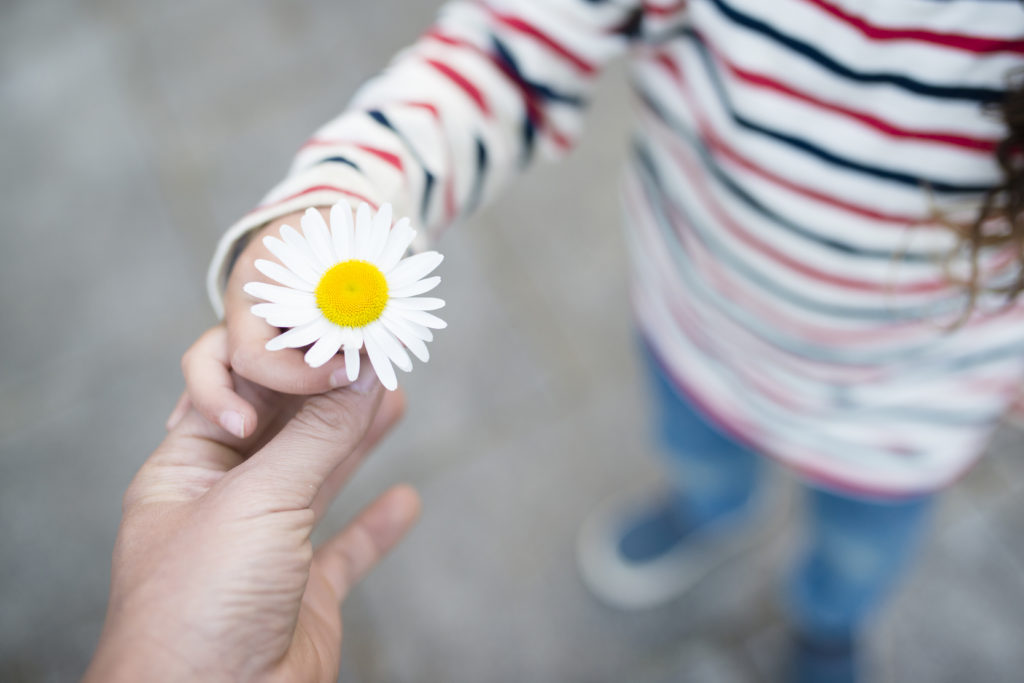
The social experiences, the other half of empathy, develop from social interactions and observations. These social interactions are in the everyday experiences such as, “Watching how our parents treat others, playing and fighting with our friends and siblings, and learning from our parents about recognizing right from wrong.” Once we grasp the concept that something can be or feel different for you than it was for me, we begin to learn that the way he/she experiences the world is different from how we do, and we’re OKAY despite this revelation.
If empathy is a two-part equation, then we know one can develop without the other, however there will be a noticeable imbalance. We are well aware that when our students come into our classrooms they are each entering at their unique developmental stage. In general, we are conditioned to think it terms of academic skill sets. However, we also know that when teaching young children their social and emotional skill sets are just as important, if not more so in the first few weeks or months of school. Social cues, emotional readiness, collaborating with others –every academic skill you put before them will require these skills.
Ashley shares the ideas that came to her mind after reading about the empathy section:
Before our playtime we will discuss reading the body language of others. We will talk about using words to get more information when a situation occurs. We will discuss that it is important to ask 1) Are you okay? 2) What do you need ? 3) How do you feel? I will create a chart that helps them sort and look at the different faces people make if they might be upset. I will use the chart on page 58… Figure 4.7.
We will go off to playtime. During play I will monitor for situations to occur. If there are any issues, we will stop and discuss them, and I will help direct the students by having them ask if they are okay, what they need, and how they are feeling.
We will resume play.
After playtime we will wrap up and discuss our lesson, and any time we used it during play.
Ashley goes on to share..
One thing I do in my classroom is called a peace talk. If someone is upset about something they get the attention of the person. Let’s say Carol and Mike are having an issue with cutting at the water fountain.
Mike: “ Carol I didn’t like it when you cut in front of me at the water fountain…”
Carol: “I’m sorry that I cut in front of you.”
They might high five or handshake…
This works great in my classroom. The students are able to voice their issues with each other, and they are not coming to me to solve their problems. During the start of the school year I am there to monitor and guide them in this, and towards the end of the year they are having peace talks on their own.
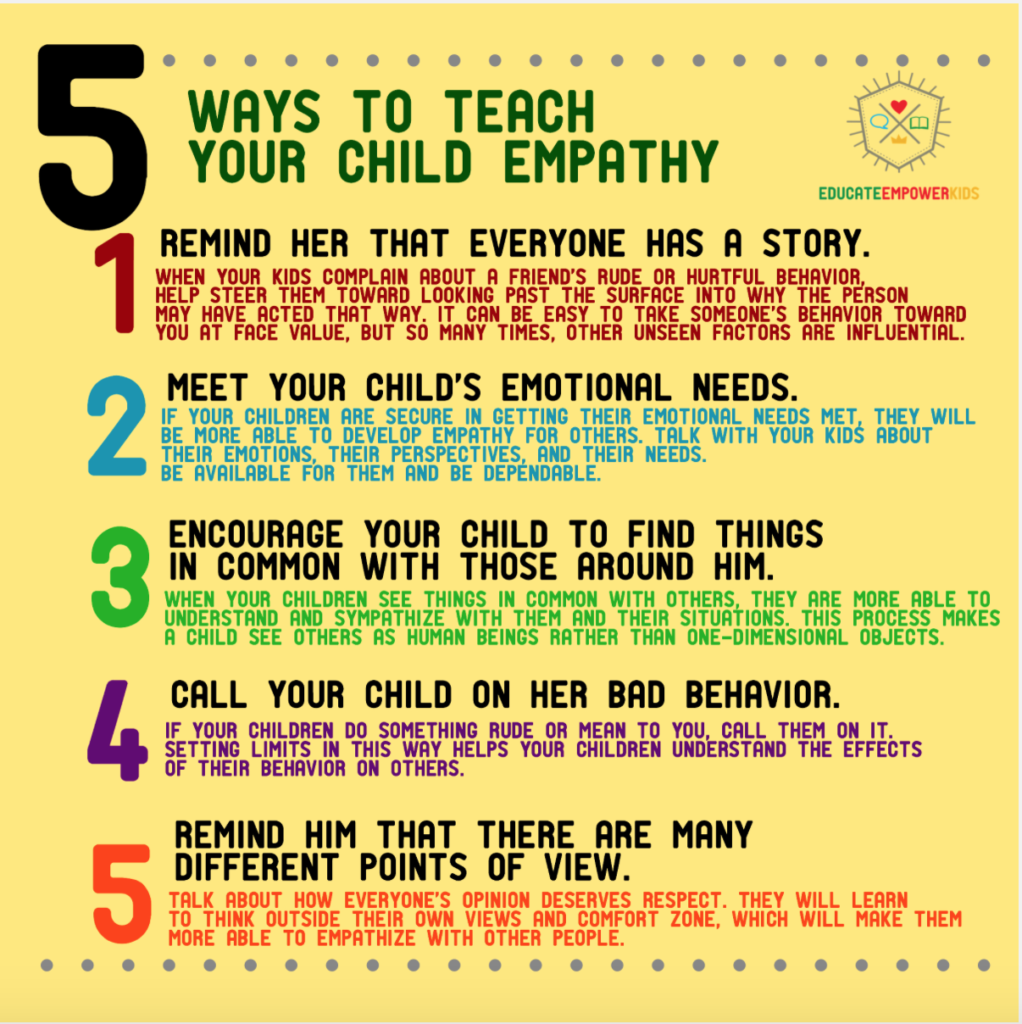
Choosing Empathy Means Choosing Play
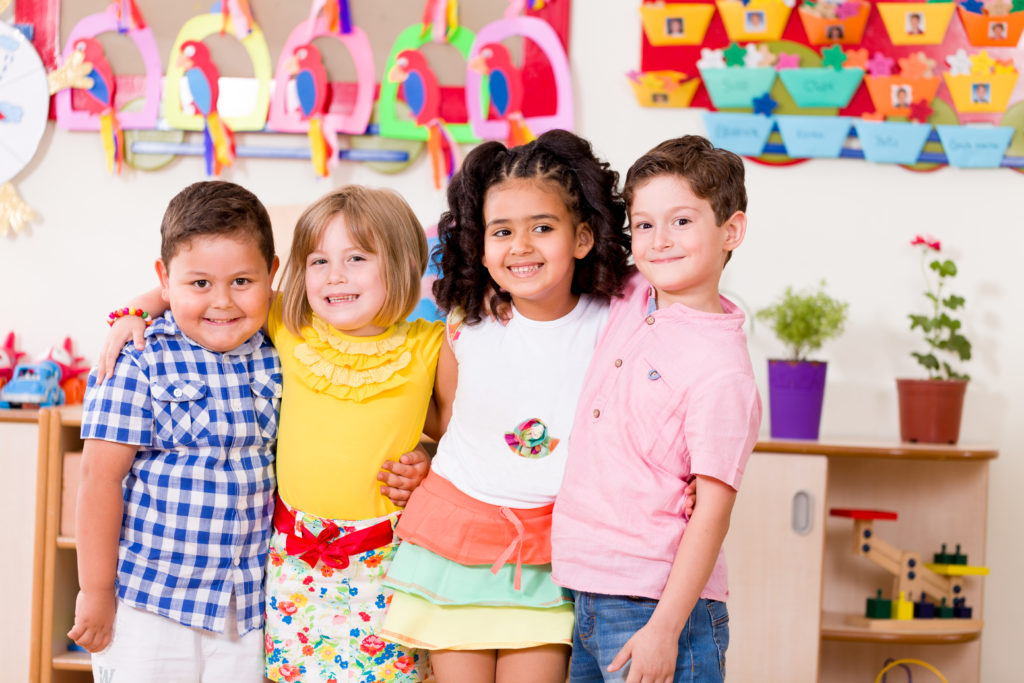
What can we do? Why is it our job to let kids “play” when they can easily have these experiences at home? We know the answer to both of those questions. I can also assume its safe to say that many of us a teachers innately bring these experiences to our classroom without specific intention. Just think, when we are more intentional we are able to see the growth and witness the fruits of our labor and love. It is our job to let kids play. As we have discovered thus far, empathy relies heavily on social interaction and our classrooms can either foster and make time for play or inadvertently dismiss the importance of play. We want to develop strong minds and hearts, “as educators we must provide opportunities for children to engage with each other and adults in a robust, social manner.”
Exploring Empathy in Play: Focus areas 1 & 2
We discovered early on in this section that learning to be empathetic takes time and repeated experiences. Another key to success is a reflective teacher who is able to discern what experiences to bring into their classroom to further develop and foster empathy. What does this look like? We know it doesn’t need to be separate block of carved out playtime. It must fit into our daily schedules and allotted instructional time. Instead, we can divide this important work into two instructional areas: “Studying Faces and Bodies to Understand Emotions (My Own and Others)” and “Taking on Roles to Build Perspective Taking.”
The authors provide us with some sample teaching sessions for Focus Area One that we can easily tailor to fit our classroom dynamic. Much of the activities we select and our time spent practicing empathy should be a direct reflection of the needs of our specific classroom. An outline is provided outline to help you visualize what a typical instructional lesson might look like in your classroom.
This leads us into Focus Area Two. Remembering that understanding empathy is only half of the equation –we must be prepared to teach children how to step into another’s life as much as possible. Role play, or fantasy play, works to “lay an essential foundation for perspective taking in everyday life.” The authors again provide some great sample lessons to help us implement these experiences for our students in the classroom.
Laura shares some additional ideas for bringing role playing into our classrooms:
In the house area; children can take on the role of a parent, babysitter, baker, grocery store worker, etc. The block area provides children the arena to become architects, astronauts, fireman, policeman, etc. Farmers, vets, and zoo keepers just need a bucket of animals and their imagination. The writing center can be transformed into a teacher’s desk and or an office. The possibilities of role playing are endless when two play areas are blended into one. Acting out a variety of scenarios by storytelling allows their play to go in many different directions. As children add their own individuality and collaborate amongst each other, their roles become their own.

Is it Done? Are We Emphatic Yet?
The authors simply state, “Teaching into empathy is never done.” We know as educators as with any skills, we expect to revisit as the child matures throughout the year, or years. It is important to be reflective and keep a pulse on your individual classroom to know when to revisit or move in a different direction. As your students’ play evolves you will see the direct affect linger in other curriculum areas. Below are a couple videos that show empathy! You could simply revisit empathy with a quick video and follow up conversation!
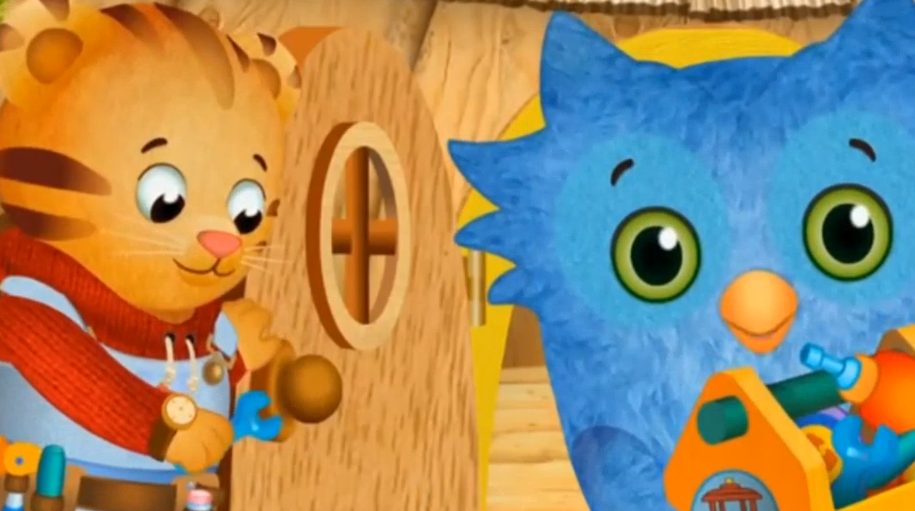
Curriculum Connections: Empathy
Being open to the idea of creating space and time in our classrooms to develop our students’ social emotional skills through play has benefits that are multifaceted. “Capitalizing on the foundation you have built in paly will male these transitions to academics powerful and rich and more meaningful to children.” Let’s explore the benefits:
Reading
The emotional vocabulary that children acquire through repeated exposure leads to deeper understand of the text. They are able to understand and possibly connect with a character and how the character might feel. Opportunities in role-play allow children to understand point of view, as in realizing it is one character’s interpretation of an event. Hint: Fairy tales are great for this!
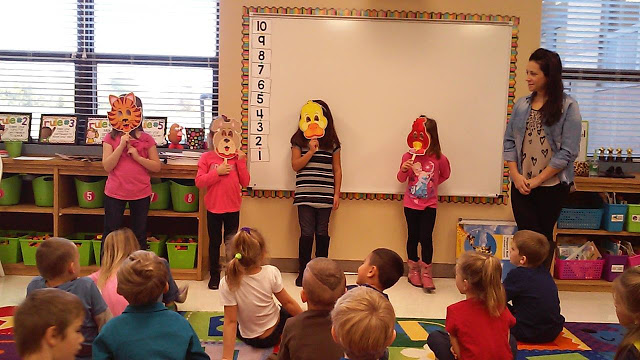
Writing
Role-playing supports dialogue and helps children move from a summary writing and grow into story tellers. Role-play can support both imaginative writing and true stories. When children have practice in engaging in fantasy play they can more easily tap into their imagination and get creative in their story telling.
Social Studies
When we take the time to practice and teach empathy we are setting the stage to build a more caring classroom community. Play is at the heart of widening student’s understandings of the world around them. Role-playing, field trips, photographs, the list keeps going. These props, experiences, and opportunities open the door to dialogue and help to build students’ background knowledge.
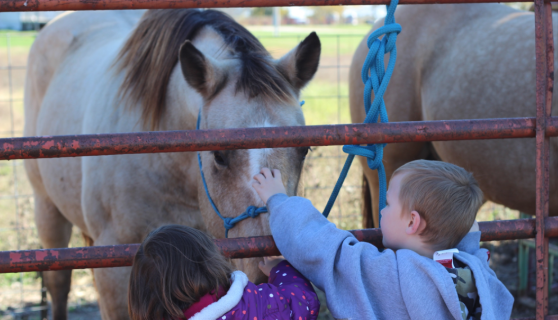
Myra shares her thoughts,
My biggest take away from this was from page 68 “When problems arise around issues of empathy (or lack thereof), resist the urge to solve them. Instead, facilitate a community conversation that puts the power of action in the hands of the children.” We have what we call “family meetings” each day in our classrooms. I foresee using the situations that arise during my play block to discuss in our family meetings. This will be a great place to facilitate conversations and problem solving from the kids point of view. I absolutely loved the curriculum connections involving Empathy. I can’t wait to watch the transition of my kiddos!
Playing Together: Teaching Kids to Collaborate and Negotiate
We are a being who thrives on interaction and physical closeness. However, collaboration and negotiation are not the same thing as physical closeness and instinctual interaction. For many people, they lack the skills necessary to collaborate with groups of individuals and because of this challenge are unable to see the bigger picture outside of themselves –working towards a greater goal that can’t be achieved alone.

Collaboration: An Exploration
We know that collaboration enhances business and work performance. It is a sought after skill that has become an essential component of continued growth and success in the business world. The same is true for student learning. We now understand the importance of fostering collaboration and that various perspectives help us to creatively grow in ideas. The authors define collaborations as, “an action, a way of approaching others with attitude that thinking together will always yield more results than thinking alone.” We see this at work in our classrooms during puzzle activities, group investigation, and even in writing through the use of double entry partner journaling.
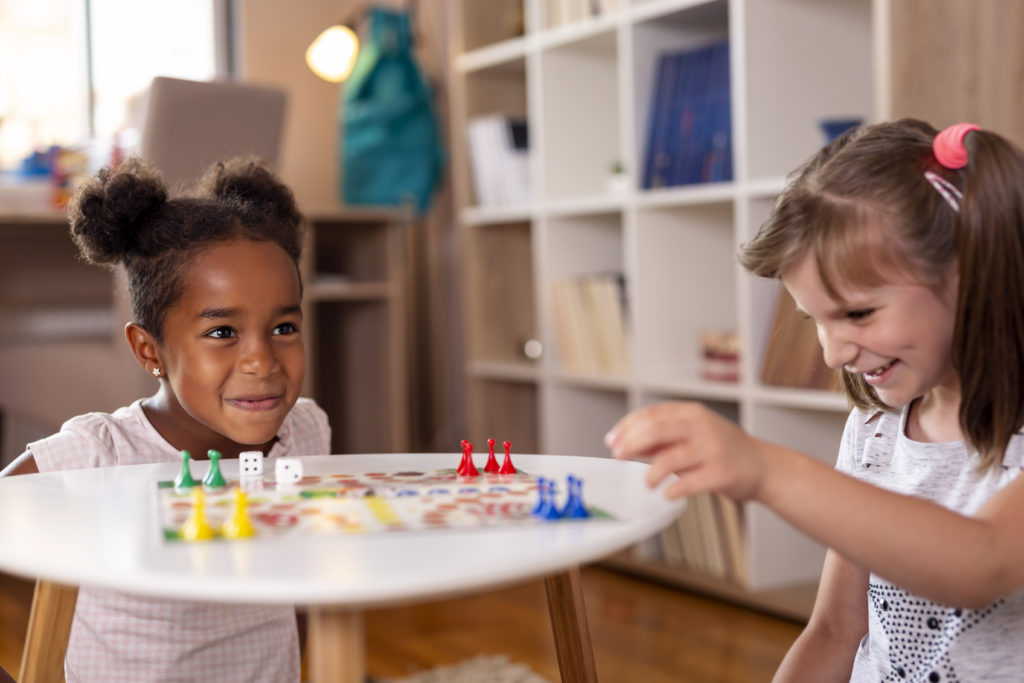
Play Means Learning to Collaborate
So we know collaboration is a great thing. We also know that in order for collaboration to be successful we need more than cooperation. Howard Gardner’s theory on multiple intelligences states “interpersonal intelligence” must be developed in order to effectively collaborate. Interpersonal intelligence is defined as “the ability to organize groups of people around a common goal, prevent or resolve conflicts, negotiate solutions, and make personal connections with others by recognizing and responding to others’ feelings.” (A true vision of what we hope for in a glimpse into our classrooms!) Some of us naturally excel socially –for the majority of the population we need exposure, practice, and guidance to strengthen our interpersonal intelligence. Cue play. In its most natural intended form, “play is nature’s way of teaching children how to solve their own problems, control their impulses, modulate their emotions, see from others’ perspectives, negotiate differences, and get along with others as equals.
In self-initiated and self-directed play children are able to create their own rules and make necessary compromises. As opposed to adult-organized games in which the adults are setting the rules, making the decisions, and assigning roles. When we think about all the decisions that are made for them day-in and day-out we realize the necessity and impact of free play.
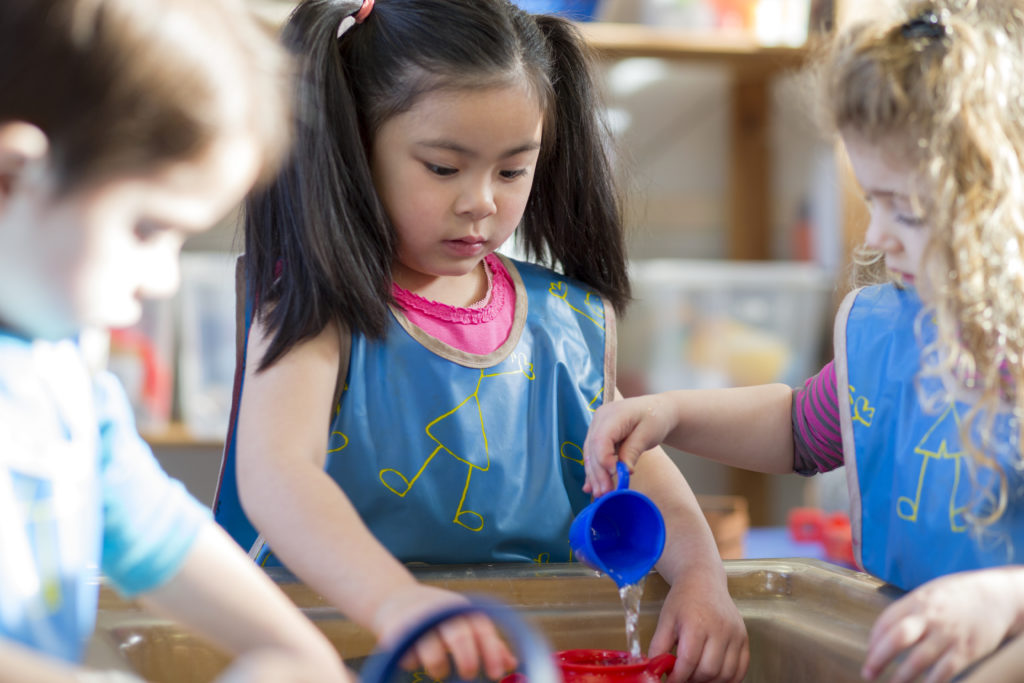
Collaboration Means Learning How to Self-Regulate
If free play is important and children are going to learn and practice the skills necessary to collaborate –then what happens when conflicts arise? Believe it or not we must allow children the safe space in which to learn the practice of self-restraint and the ability to sustain their play. This is a life-skill that is often practiced best in collaborative play. Yes, we need to be able to scaffold their language and communication skills, however we must step back in order for children to learn about the give and take of communication independently.

Collaboration Means Learning to Communicate
Communication. This is a necessary skill for any healthy relationship be if professional or personal. Social language is developed through our experiences. For children this happens in pretend play, role-play, acting and drawing to name a few. Again we must be prepared and willing to provide the space within our classrooms and time for students to learn the skills of collaboration.
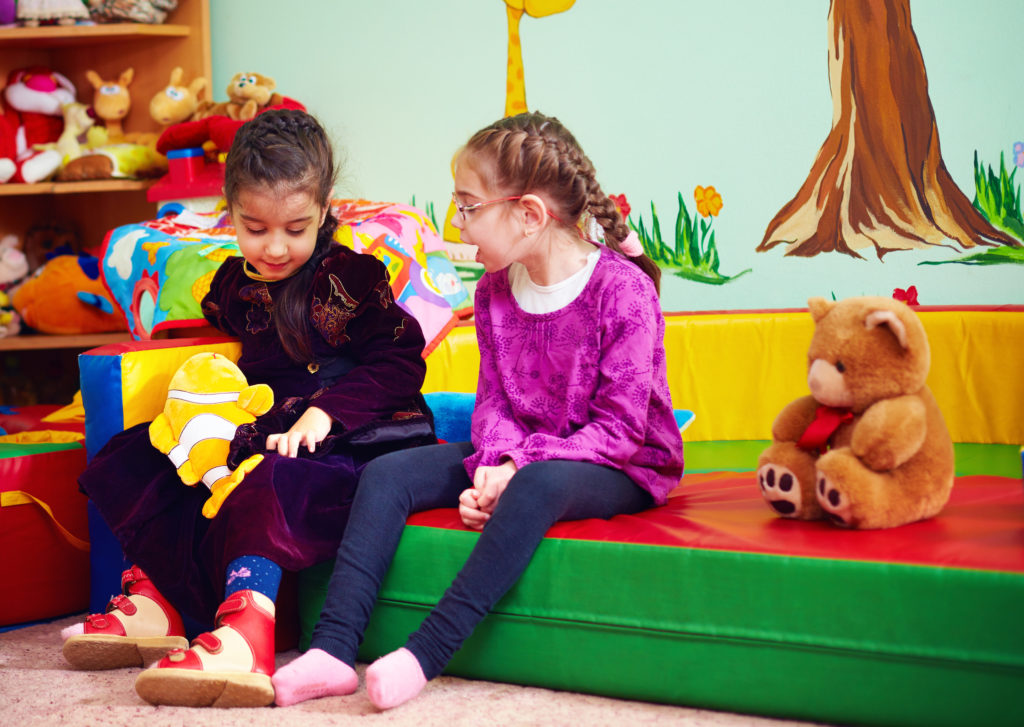
Exploring Collaboration and Negotiation in Play
Focus Area: Playing Together Means Working and Thinking Together
The authors provide great samples and resources to use as you plan and formulate a plan to include collaborative play in your classroom. We know our students will flourish in their work that is play if we continuously provide explicit ways in which we encourage effective collaboration and negotiation. On pages 76-82 of the text the authors give examples and teaching sessions for thinking and playing together! My absolute favorite one was discussing if the problem is a glitch, a bummer, or a disaster! The authors then give you examples on how to walk the kiddos through each of those and include sample anchor charts!
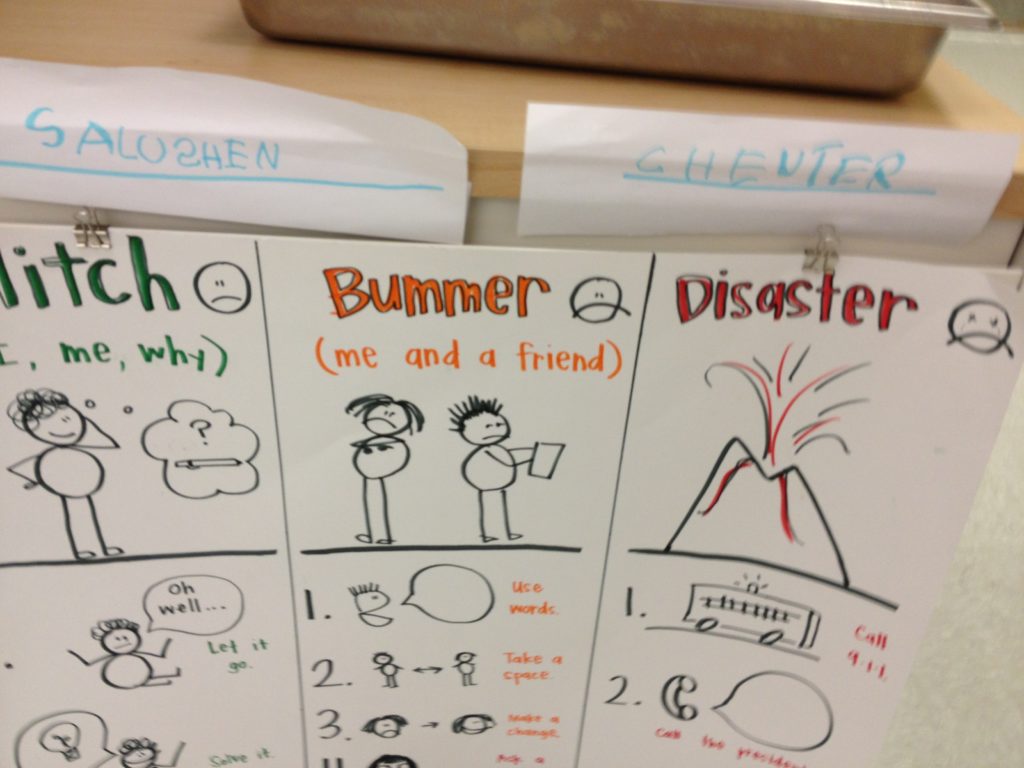
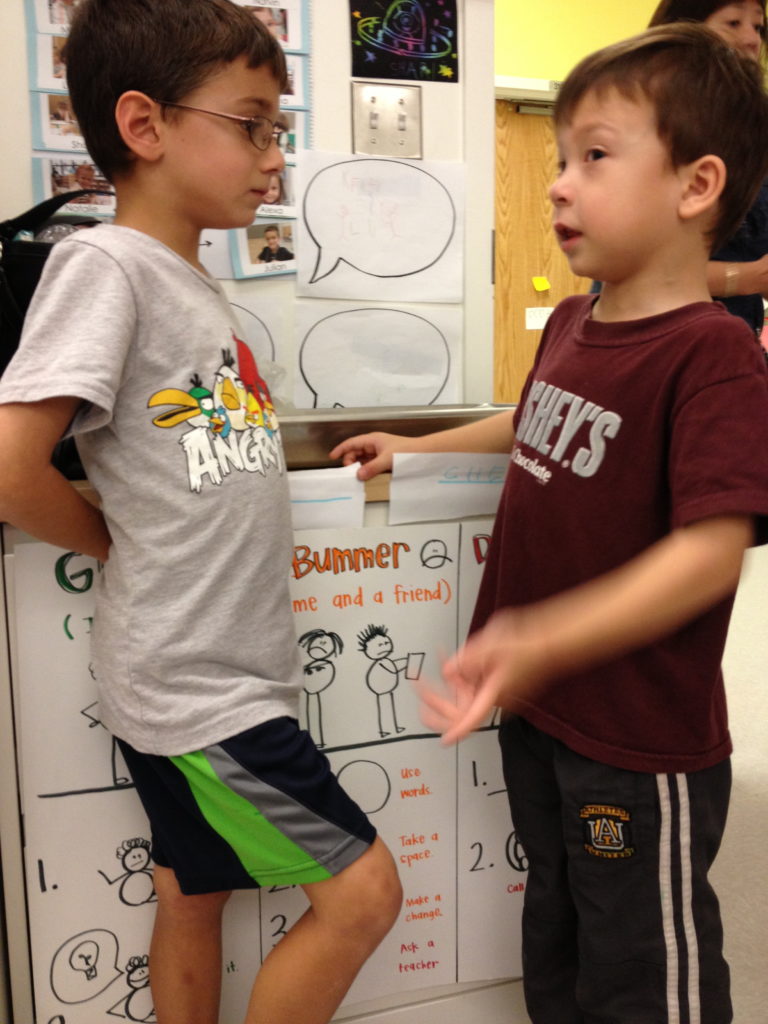
Diane shares,
I would foster negotiation and collaboration through games and partner work in the classroom. Stem activities where the children are asked to accomplish tasks is a great way to collaborate! Dice games foster those skills also along with free games at recess. Fairy tales are also great as the children select roles to be the characters. All of these skills are so important in the children’s growth in the classroom. I often have the children vote on activities and talk with their shoulder partner to make decisions!
Play and Growth Mindset
This topic is one that has really been of interest to me! Many of us have adopted one of two types of mindset –fixed or growth, or a combination of both. The most incredible fact about mindset is that our brains actually have the ability to be rewired throughout our lives. We have the ability to shape and help reframe the mindsets of our students and the dispositions that come along with it. Environment can foster and stimulate change. Powerful. Encouraging, to say the least!
So what is the difference between the two, fixed and growth? Those with a fixed mindset often believe things should come easily to them. If they try and fail then it simply means they aren’t any good and should give up. These individuals tend to avoid challenges and may give up easily when faced with a difficult task.
Those with a growth mindset believe if they keep trying or practicing they have the opportunity to get better and eventually succeed. These individuals are the ones who step up to a challenge and aren’t afraid to make mistakes. A key characteristic is their ability to be reflective and learn from their failures.
It is true that many of these characteristics are innate, we are born with a certain disposition. However, I go back to the point that mindset can be modified, it can be nurtured and we can provide a safe space in which our students are challenged to grow and exposed to opportunities to see and know different than previously in their social interactions.
Grab a freebie growth mindset mentor text **HERE**
Exploring Growth Mindset in Play
It is to be expected that not every child is coming into our classrooms with the ability to play –get along with others, negotiate, express empathy, and work collaboratively. They may not have positive experiences that fostered growth mindset. Just as with academics you will have to assess your students’ level of play experience. We don’t need pencil paper tests for this of course. I’m not talking traditional assessments. I’m referring to really canvasing your students. Do you notice during carpet time pangs of frustration, negative self-talk, or aggressive behaviors for example? Do you hear problem solving, witness empathy, flexibility? These are the things we are looking for. Once we establish what the pulse of our classroom dynamic is we can put into practice various strategies that will foster growth mindset.
As in previous sections, the author leaves us with a great list of strategies as well as possible teaching sessions that can easily be used and adapted to fit your classroom needs.
Roxane shares her take on the growth mindset and play,
The growth mindset spoke to me. I appreciate the direction the author was saying about students often take in comparing their accomplishments against others in their class. I make sure I start the year of with the lesson on perseverance, so they get the importance of “not yet.” I use this word often in my dialog with my students. I let them know that I too have to practice to get better at small things in life. Our current culture wants things immediately and kids are not used to waiting for the reward. Letting students persevere through their own growth will help them in the future. I liked how the author encouraged us teachers to acknowledge where students made a growth mindset instead of always praising the final outcome. I am going to work on this acknowledgement this upcoming year.
Christina gives and example of fostering growth mindset in her classroom,
I think it is important to start a foundation of growth mindset prior to play, but once introduced, it is something that I use throughout my day. In play, I see it most often coming up with building area in choice time, kids easily are frustrated when their creations don’t work as they visualize them or they break etc. I think providing them a visual chart that we create together about how to self talk when things are hard, providing engineering sheets so they can see the mistakes as less of a mistake and more as a guide to see how to try something different, and less as a failure.
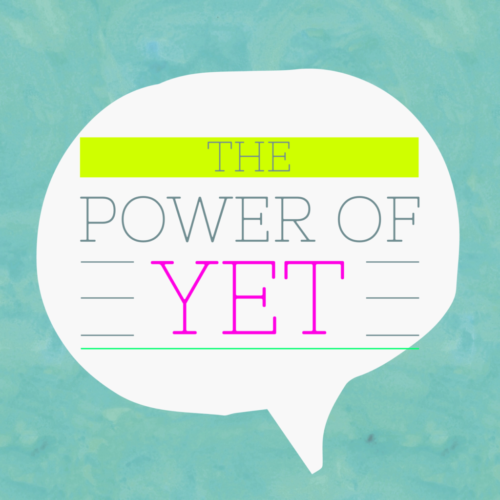
The Promise of Yet: Thinkers Grow in Reading, Writing, math, and the Content Areas
The end of this section focuses on the importance of assessment applied through the lens of a child. Instead of assigning numerical evaluations and pass/fail we should instead use the “not yet” concept. A child on the receiving end of a 1 might think they are failing or not good enough. However, when we offer a “not yet” scoring approach it gives the child hope. Then, we build upon this offering strategies and support that assures the child if they work hard and keep trying, just because they aren’t there yet, certainly doesn’t mean they won’t sometime in the near future.
We will conclude with Bree’s take on section 2,
I think that the most important thing to remember is; you need to instill a growth mindset from day 1, in all areas, ALL the time!
By this I mean it is so important to teach littles that;
* Mistakes are opportunities to LEARN!!
* (Not YET) is so powerful!!
* Stick with it! (Persevere)!!
Bree goes on to share,
Especially in kinder we need repetition, consistency, patience, and LOVE!
Because I’m coming back to kinder after a little bit away, I plan to incorporate play throughout our day. It will be important to remember these three principles. I plan to build anchor charts for each one with my class at the beginning of the year. We will post them in the room and revisit them often! I think it’s important the kids create the charts with me so that they are invested in the process and find value in the principles.
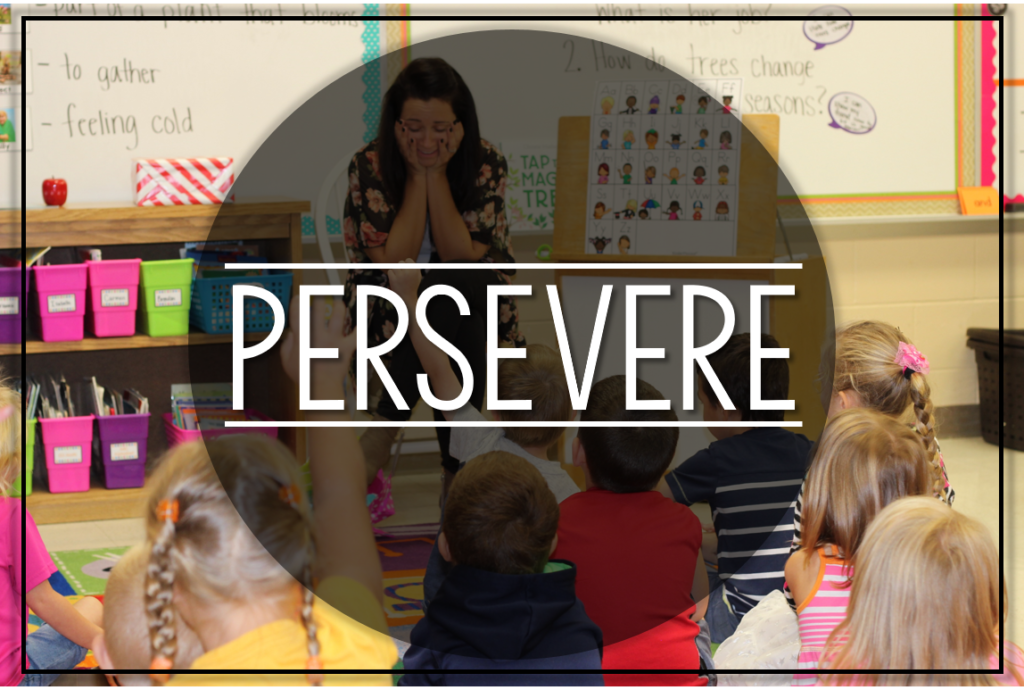
Lastly, I would like to (re-share) my quick but POWERFUL lesson on perseverance! If you’ve followed me very long you have probably heard of this lesson but it would be wrong of me not to reshare!
Have you ever wanted to make that ONE impact on your students each year? That ONE lesson, that ONE book, that ONE experiment? Well, what about that ONE word…. one word that you could instill for them that they would be able to use for the rest of their lives… that word is PERSEVERE!
About four years ago I sat down for a professional development training and the presenter started talking about how teachers have lots of cutesy signs, posters and decorations in their rooms… but were those things even meaningful to the kids? I felt as though I was in the clear because I was certain that I had the bare minimal on my walls. (secret inward laughing here) However, I did have this thought that a class “word” or “motto” would be fun and something that I knew my kiddos would really buy into! As I sat there longer a word immediately came to mind… persevere! The word persevere was a strong word… would my kindergarten students really get this word? Would they understand it? The further I thought about it the more I knew I had to tackle it because if I could get them to a level of understanding then this word could be like MAGIC. (insert professional development mind wandering here).
I pictured the student wanting to give up at reading group.
I thought about the student that insisted math was too “hard.”
I remembered back to “Johnny” and how it took every ounce of energy he had to get himself out of bed, ready and out the door all.by.himself.
I wandered back in time to the first day of school when “Suzy” wouldn’t budge off the sidewalk to come into the classroom.
I knew there would be times we could CELEBRATE our classmates’ perseverance and there would be times that we would ENCOURAGE our classmates to PERSEVERE.
But HOW would I teach my students all about this big word… let alone … have you asked a youngster to SAY the word persevere?
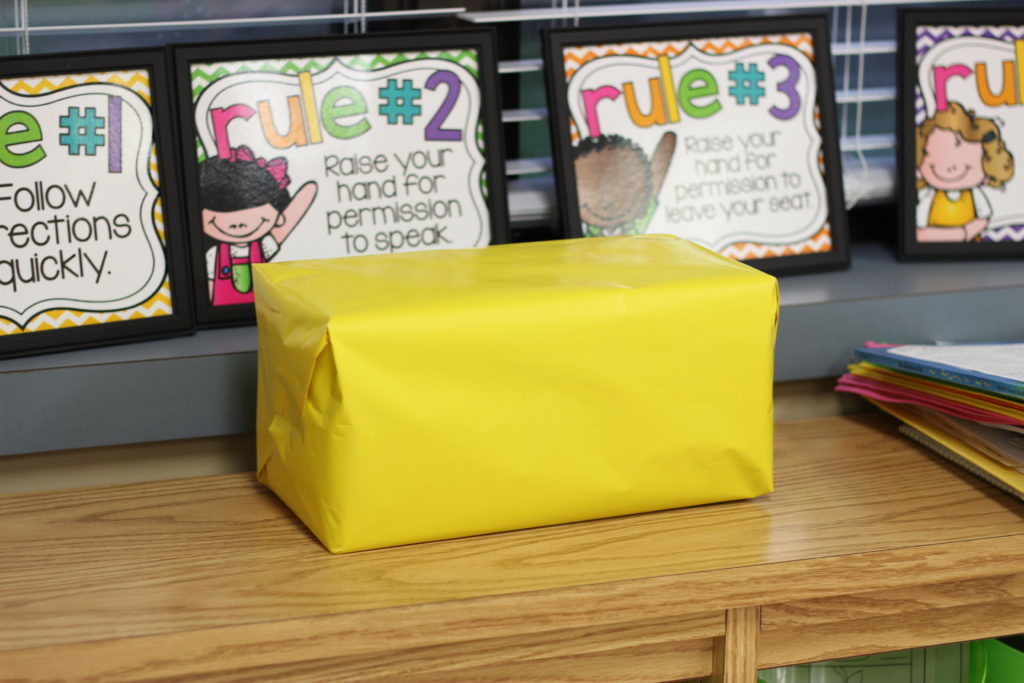
Yep. It was all wrapped in a box. No ribbon on top but that is completely optional. I let this box sit on my counter for a day. (THIS WAS SO HARD FOR THE KIDS.)
Kids: Mrs. West, aren’t you going to open you present?
Me: No, I don’t think so.
Kids: (insert shocked stares here.)
………… an hour or so later
Kids: Mrs. West, aren’t you going to open you present?
Me: No, I thought about it but then I decided not to because I might mess it up.
Kids: We can open it. We are GOOD at opening presents. We will show you.
Once you get the volunteers then you know that you can’t hold them back much longer, ha! So it’s time to turn up your acting skills! Basically your job is to portray someone that is frustrated, defeated, sad and a little self-conscious about making mistakes.
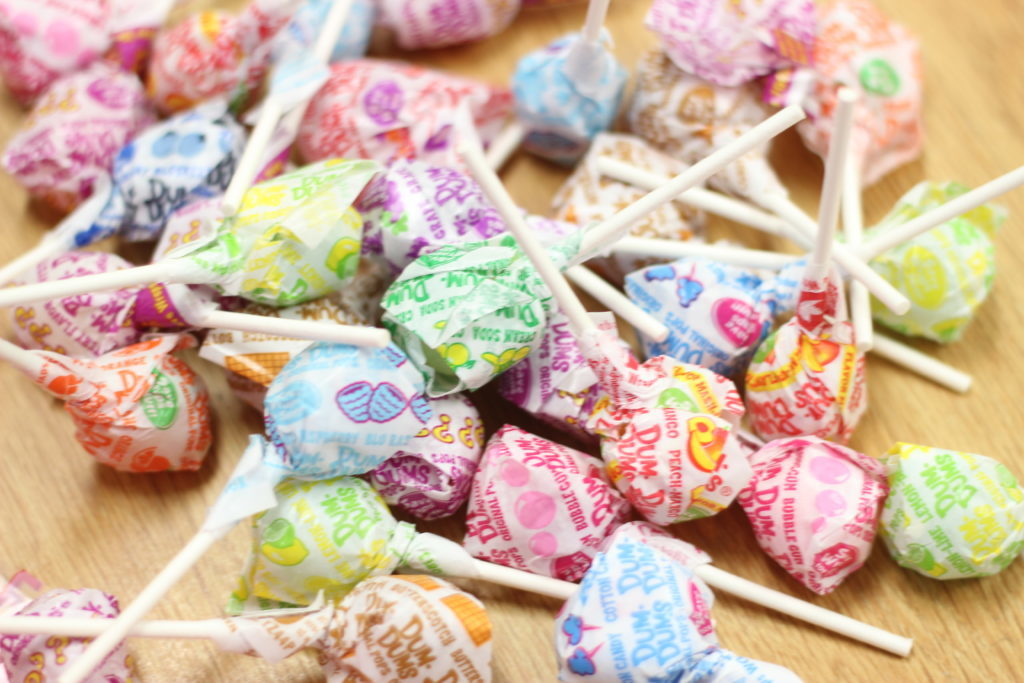
You will have prepped the “present” by wrapping some “goodies” (suckers, rings pops, stickers, etc) inside a box. You will then wrap the box SEVERAL TIMES. I like to alternate colors to help myself remember! You can also use additional boxes- that is extra flare for them!
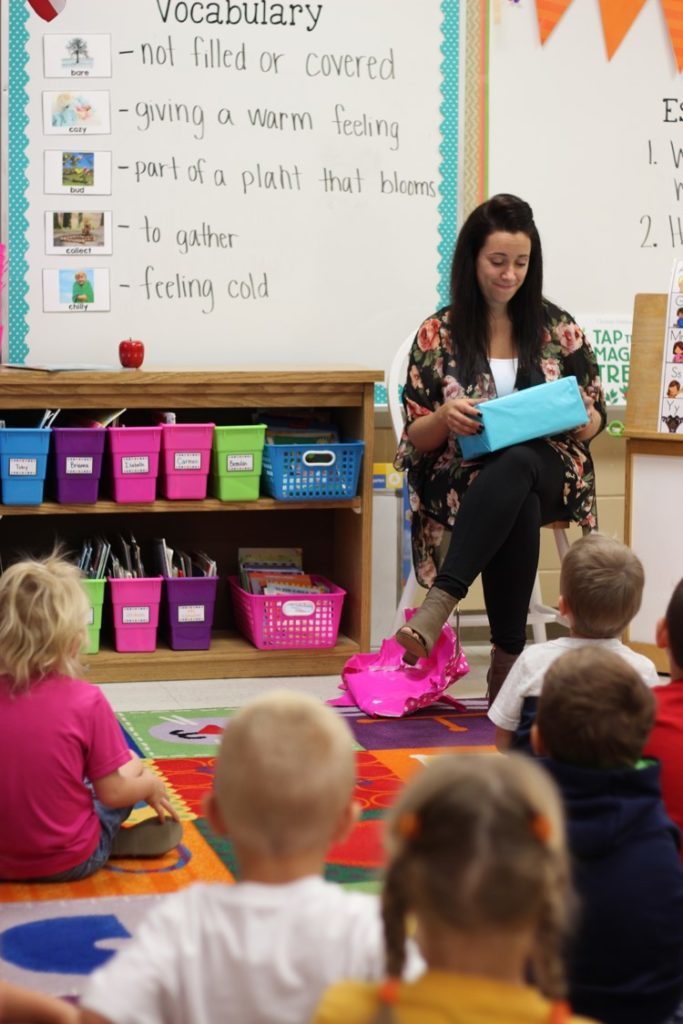
After they finally convince me to open the box I usually try look real serious at them and say… “Well what if I mess up?” They generally have the SWEETEST answers!
After those first couple layers you really have to work that “worried” look and seriously think about GIVING UP!
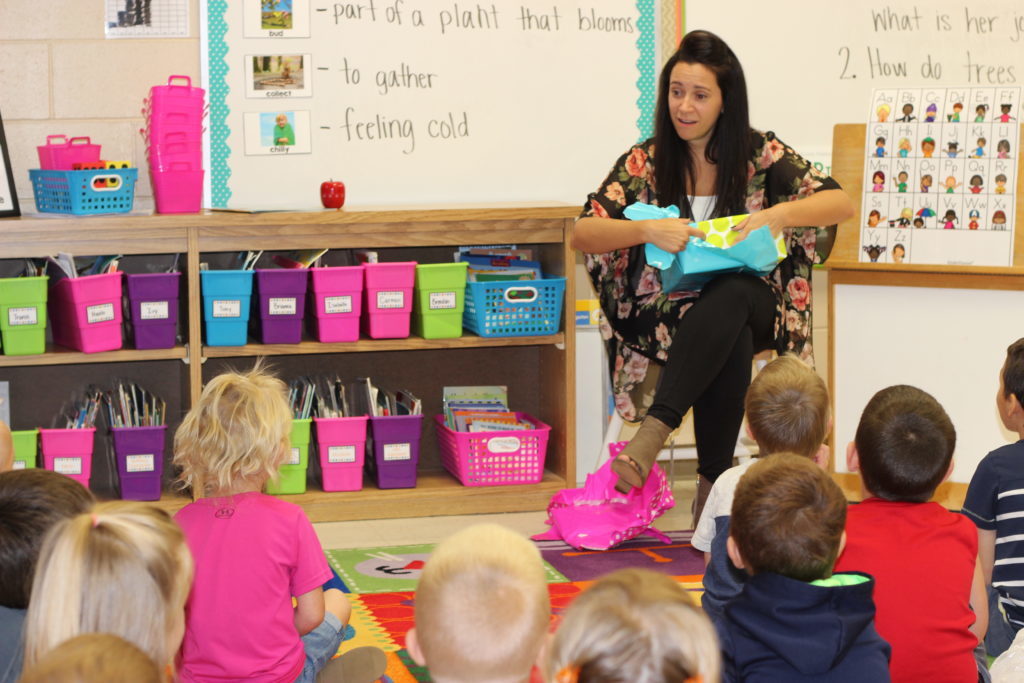
They really get into it and shout that it will be okay if you mess up. So, I take off more layers and they are amazed that there is still MORE paper. I just keep telling them that I can’t do it, I don’t know how, someone might laugh at me if I mess up, and anything else I know five year-olds will say. They are all so encouraging and continue to cheer me on like I was running in a marathon. You also have to distance yourself from the box… this pains them! They just can’t believe you would abandon your present!
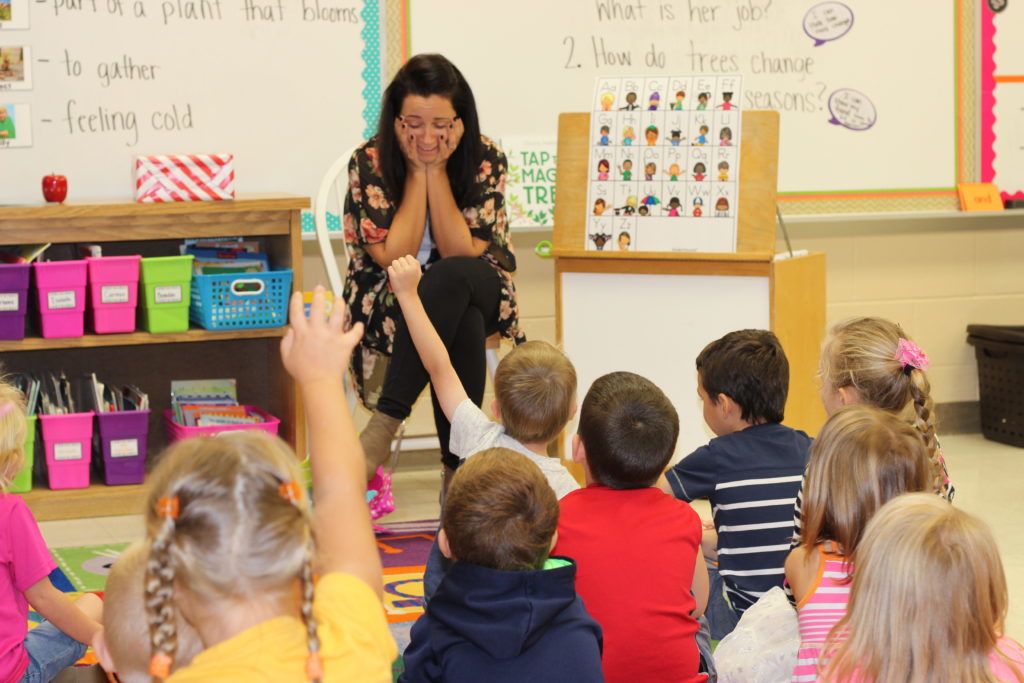
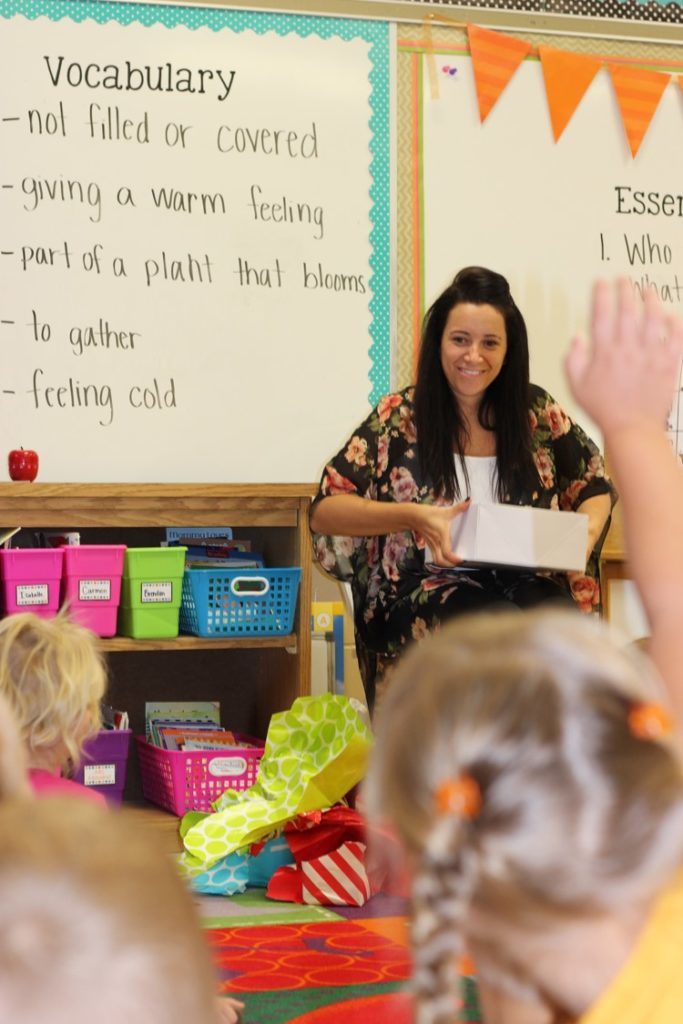
When you get to your last layer and then ultimately the “secret surprise then it is time to “lay it on thick”. “Boys and girls, would I have ever found the treats if I gave up and didn’t try? It was because you were so encouraging that I kept trying. I knew you wouldn’t laugh at me and you made me feel really good! I kept going and going… I never gave up did I? I PERSEVERED!”
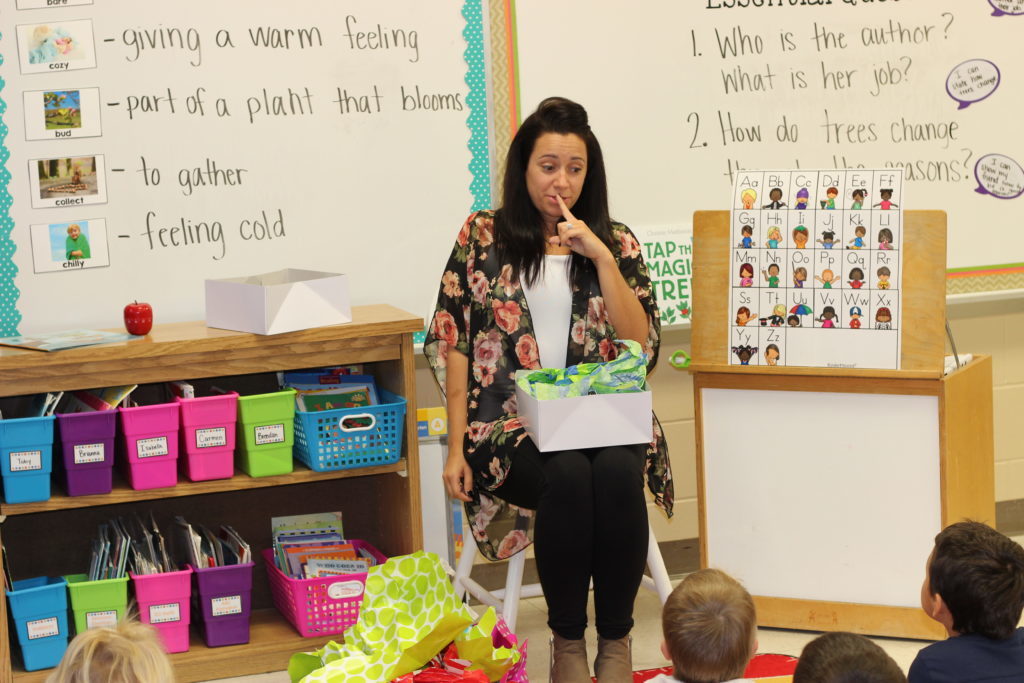
A look of the aftermath….
Now that you have heard me ramble about the lesson… you can WATCH IT!
I mentioned above that I displayed the word in my classroom! After sharing this lesson the last few years, so many of YOU have also displayed the word in your classroom! What an inspirational word to share with our students! You can download these FREEBIE letters for your classroom below!
PERSEVERE LETTERS
*For the editable set you will need THIS font!
I want to thank you again for joining me for the Purposeful Play book study! The third and final section will be shared 7/14. Again, if you are interested in picking up the book and reading along with us you can do so HERE or by clicking below!
(Amazon Disclosure: This post contains affiliate links, meaning, at no additional cost to you, I will earn a commission if you click through and make a purchase.)

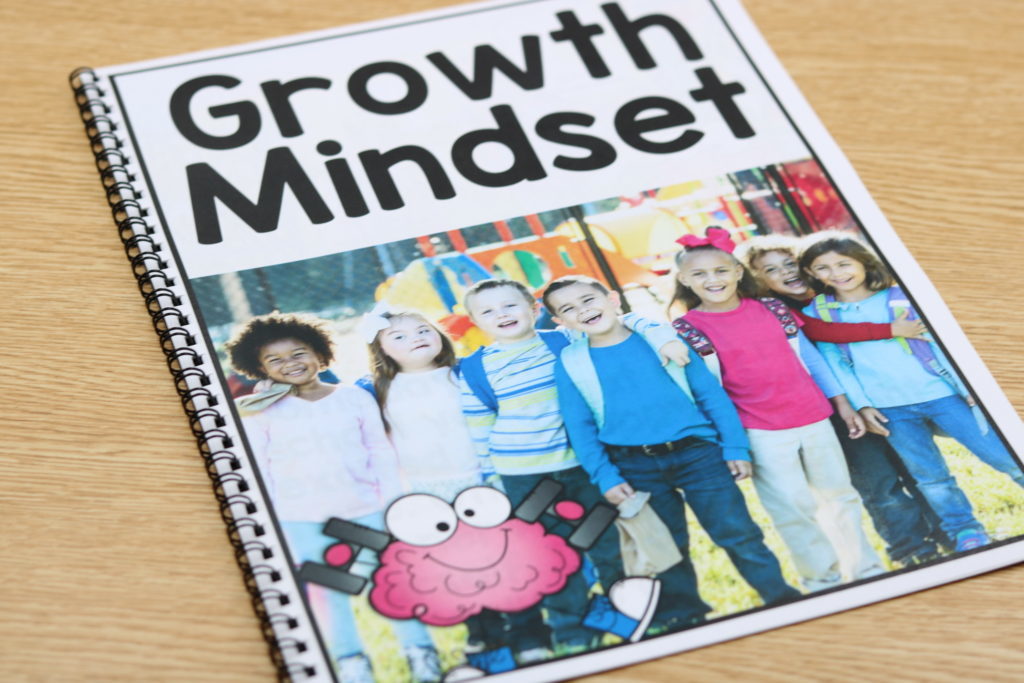
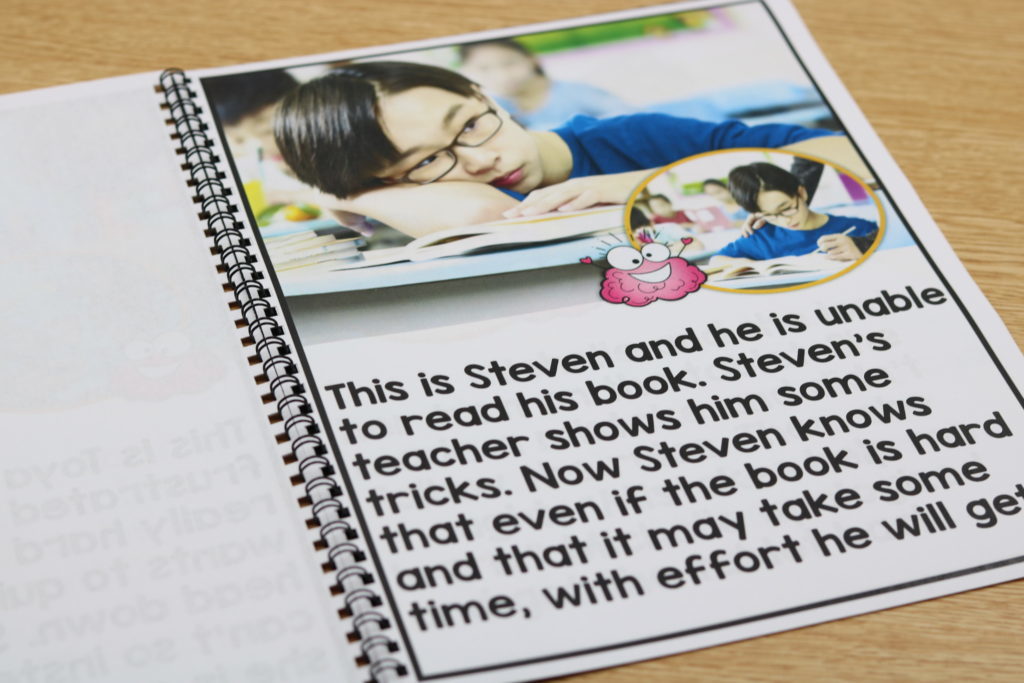

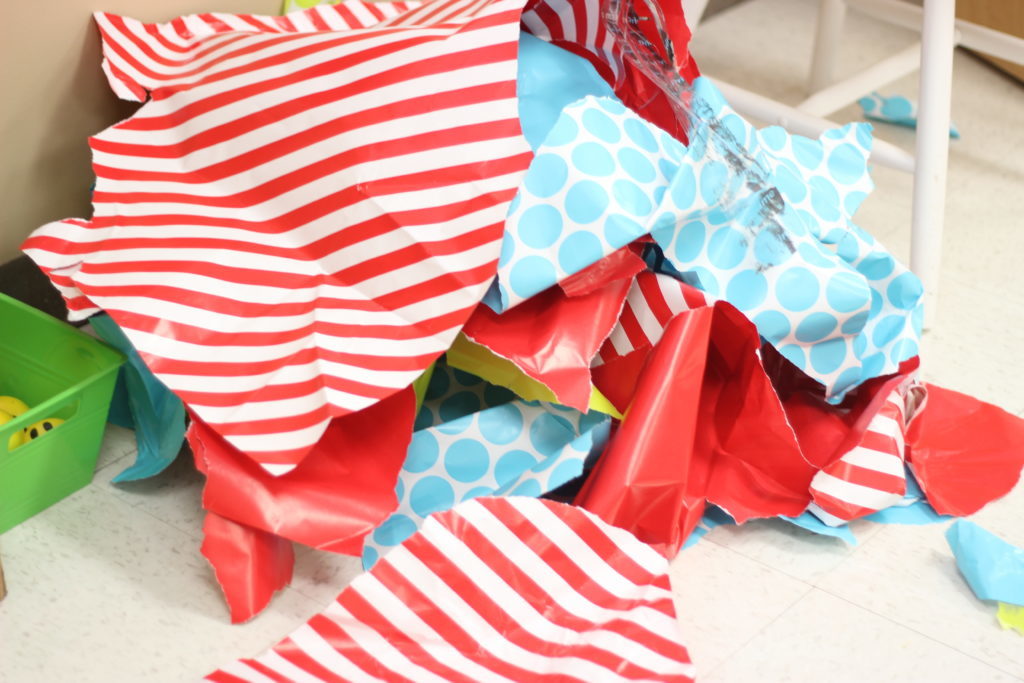
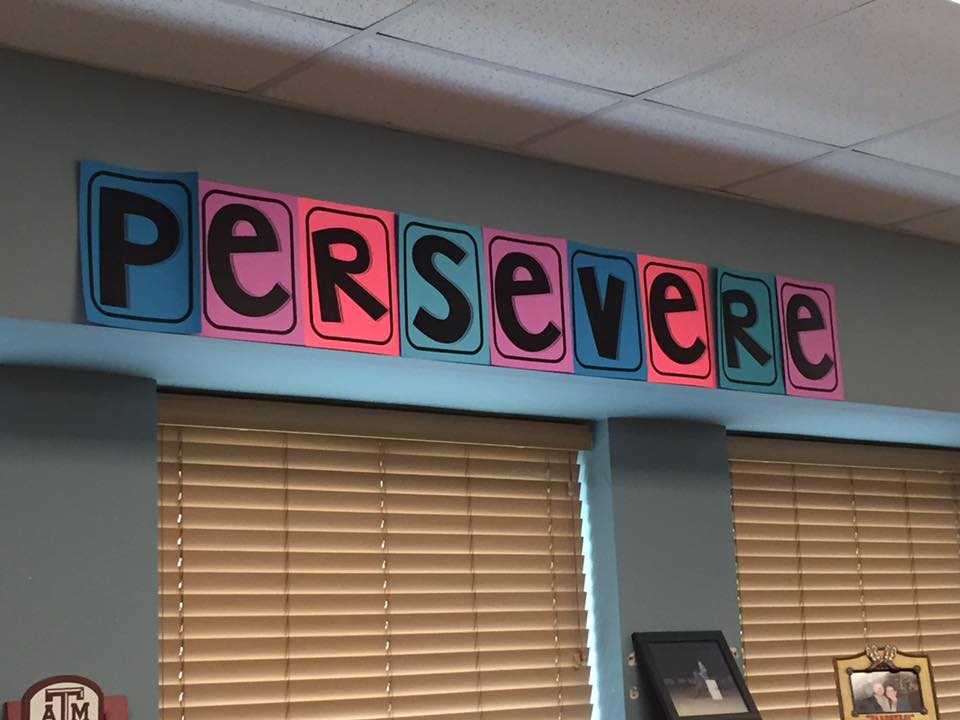
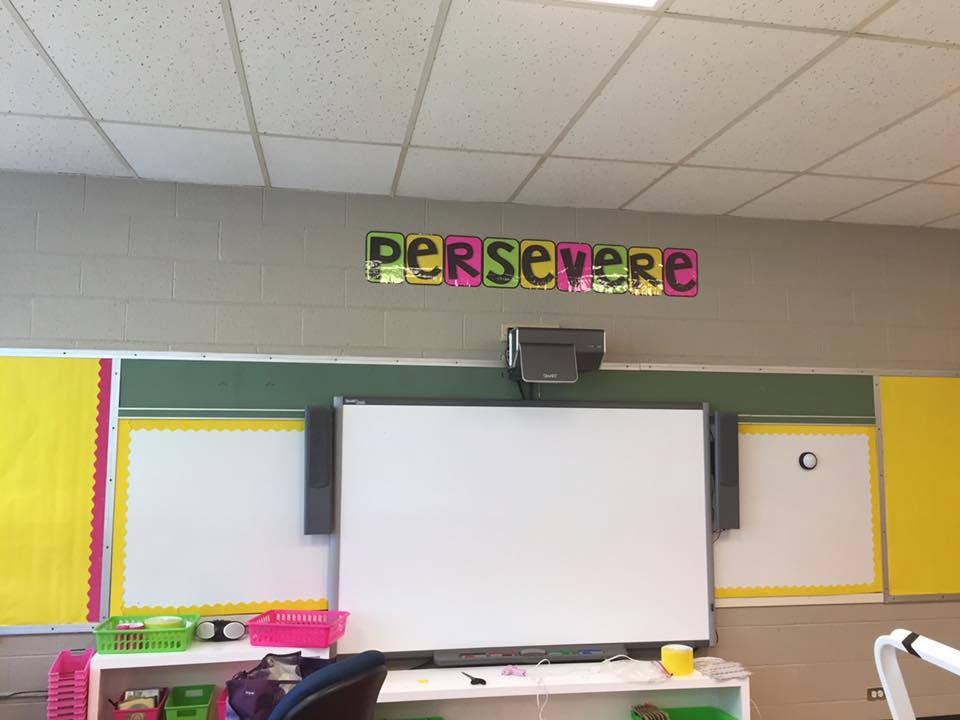
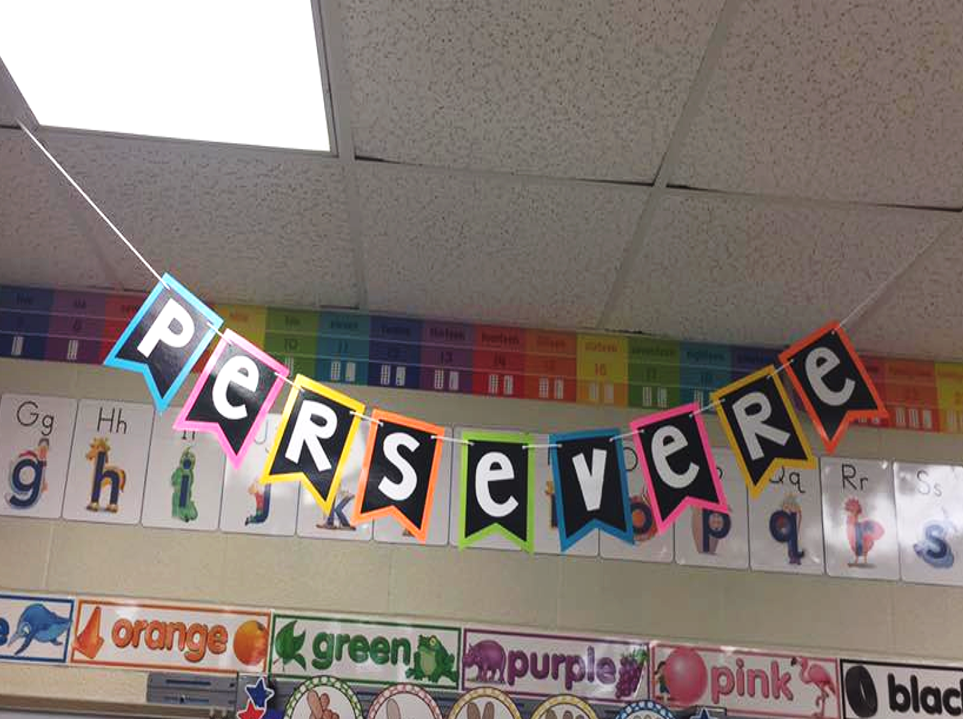
all the technical KINGDOM777 solutions and staff we need for 에볼루션 카지노 operators who provide world